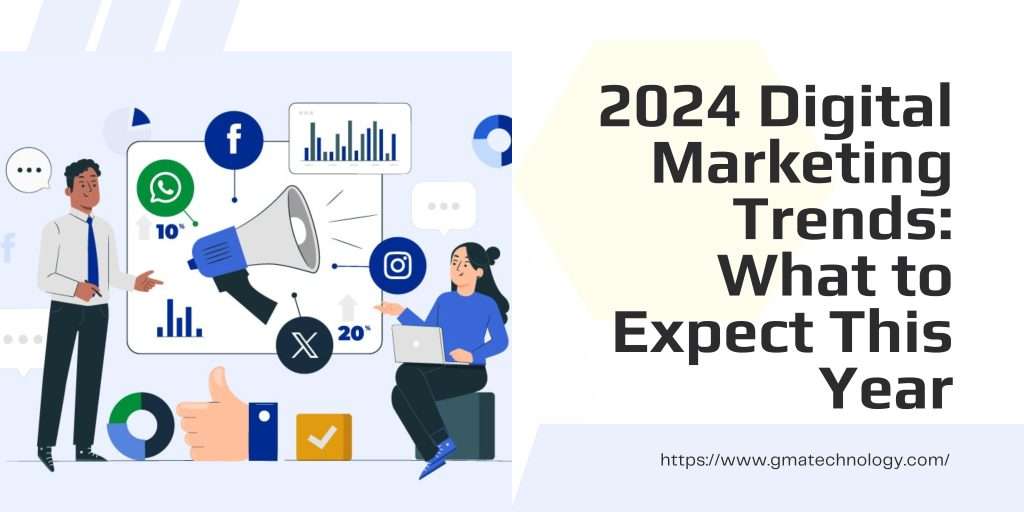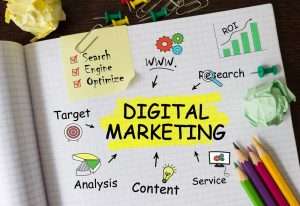2024 Digital Marketing Trends: What to Expect This Year

As we gear up for the new year, it’s time to take a look at what’s in store for digital marketing in 2024. From emerging technologies to shifting consumer behaviors, there are plenty of exciting trends on the horizon. Join us as we explore the top digital marketing trends that will shape the industry in the coming year and beyond. Get ready to stay ahead of the curve and make your mark in the ever-evolving world of online marketing!
Introduction To Digital Marketing And Its Evolution Over The Years
Digital marketing has become an integral part of every business strategy, with more and more consumers turning to the internet for their purchasing decisions. It is a vast field that encompasses various online channels and techniques to promote products or services, increase brand awareness, and drive sales. The term ‘digital marketing’ may seem like a modern concept, but it has actually been evolving since the early 1990s.
The first form of digital marketing was through emails and banner ads in the mid-1990s. Companies would send promotional emails to potential customers or place banner ads on websites to attract traffic. However, these methods were not very effective as they lacked personalization and targeted messaging.
In the late 1990s, search engines like Google emerged, paving the way for search engine optimization (SEO). This technique involved optimizing website content with keywords to improve its ranking on search engine result pages (SERPs). SEO is still widely used today as it helps businesses be easily discovered by potential customers.
With the rise of social media platforms like Facebook, Twitter, and Instagram in the early 2000s came a new era of digital marketing – social media marketing. Brands started creating profiles on these platforms to engage with their target audience through organic posts and paid advertisements. Social media also allowed for user-generated content which helped build brand credibility.
As smartphones became more prevalent in the late 2000s, mobile marketing took off as a popular digital marketing channel. Text message campaigns, app-based advertising, and location-based targeting were some of the tactics used by businesses to reach consumers on their mobile devices.
The introduction of data analytics tools in the late 2000s also revolutionized digital marketing by providing insights into consumer behavior. With this data-driven approach, businesses could track their online performance accurately and make informed decisions about their digital strategies.
In recent years, influencer marketing has emerged as a new trend in digital marketing. Brands collaborate with popular social media influencers to promote their products or services to their followers, leveraging the trust and influence these individuals have on their audience.
The evolution of digital marketing has been rapid, with new technologies and techniques emerging every year. With the growing importance of online presence for businesses, it is crucial to stay updated on the latest trends in digital marketing to remain competitive in today’s market.
In this blog series, we will delve deeper into the current trends in digital marketing and how businesses can leverage them to achieve success in their online efforts. Stay tuned!

New Technologies And Platforms To Watch Out For In 2024
In the fast-paced world of digital marketing, staying up-to-date with emerging technologies and platforms is crucial for success. As we approach 2024, there are several new developments that marketers should keep an eye on to stay ahead of the curve.
1. Artificial Intelligence (AI) – AI has already made significant waves in the marketing industry, but it is expected to become even more prevalent in the coming years. With its ability to analyze data, personalize content, and automate processes, AI can greatly enhance a brand’s marketing efforts. In fact, it is estimated that by 2024, businesses will spend over $100 billion on AI-driven technologies.
2. Augmented Reality (AR) – AR has been steadily gaining popularity in recent years and is predicted to continue its growth trajectory in 2024. This technology allows brands to create interactive and immersive experiences for their customers through smartphone apps or wearables like smart glasses. AR can be used for product demonstrations, virtual try-ons, and even enhancing live events.
3. Voice Search – With the rise of virtual assistants like Amazon’s Alexa and Google Home, voice search has become increasingly popular among consumers. By 2024, it is estimated that half of all internet searches will be conducted through voice commands. Marketers need to optimize their content for voice search by using long-tail keywords and natural language.
4. Influencer Marketing Platforms – Influencer marketing shows no signs of slowing down as social media continues to dominate our daily lives. In 2024, we can expect to see a rise in influencer marketing platforms that connect brands with micro-influencers who have niche audiences but high engagement rates.
5. Live Streaming – The demand for real-time content has led to the rapid growth of live streaming platforms such as Twitch and Facebook Live. Brands can use this technology to engage with their audience in real-time through product launches, Q&A sessions, or behind-the-scenes content.
6. 5G Technology – The introduction of 5G technology will bring faster internet speeds and lower latency, opening up new possibilities for marketers. This could include more immersive experiences such as virtual and augmented reality, as well as better targeting capabilities through improved data collection.
As these technologies and platforms continue to evolve, it is essential for businesses to adapt their strategies accordingly. By keeping an eye on these trends, marketers can stay ahead of the competition and connect with their audience in innovative ways. Embracing these new technologies and platforms can lead to increased brand awareness, engagement, and ultimately drive conversions in 2024 and beyond.
The Rise Of AI And Automation In Digital Marketing Strategies
In recent years, we have witnessed a significant rise in the use of artificial intelligence (AI) and automation in digital marketing strategies. This technological advancement has revolutionized the way businesses approach their marketing efforts, making it more efficient, effective, and data-driven.
AI refers to the simulation of human intelligence processes by computer systems. It uses algorithms and machine learning techniques to analyze vast amounts of data and make predictions or decisions based on that information. On the other hand, automation involves using technology to automate repetitive tasks, freeing up human resources to focus on higher-level activities.
One of the primary reasons for the popularity of AI and automation in digital marketing is their ability to provide personalized experiences for customers. With AI-powered tools, businesses can gather customer data from various sources such as social media, website interactions, purchase history, and more. This data is then used to create targeted campaigns that cater to each individual’s unique interests and preferences. This level of personalization not only enhances the customer experience but also increases engagement and conversion rates.
Strategies For Embracing Sustainability In Digital Marketing Efforts
In recent years, there has been a growing awareness and emphasis on sustainability in various industries, including digital marketing. As technology continues to advance and play a crucial role in our daily lives, it is important for businesses to adopt sustainable practices in their digital marketing efforts. In this section, we will discuss some key strategies that can help businesses embrace sustainability in their digital marketing efforts.
1. Incorporate Environmental Values into Branding
One of the first steps towards embracing sustainability in digital marketing is to incorporate environmental values into a brand’s identity. This includes showcasing the company’s commitment to sustainability through its branding elements such as logos, taglines, and mission statements. By doing so, businesses can attract like-minded consumers who are increasingly looking for eco-friendly and socially responsible brands.
2. Utilize Sustainable Web Design
The design of a website plays a significant role in its overall environmental impact. To make your website more sustainable, consider using energy-efficient web hosting services and optimizing the site’s loading speed by compressing images and minimizing code bloat. Additionally, incorporating renewable energy sources or purchasing carbon offsets can also help reduce your website’s carbon footprint.
3. Implement Green Advertising Practices
Digital advertising often involves the use of large amounts of energy resources such as data centers and servers. To minimize its impact on the environment, businesses can opt for green advertising practices such as using targeted ads instead of mass marketing campaigns or choosing ad networks that prioritize renewable energy sources.
4. Embrace Sustainable Content Creation
Content creation is an essential aspect of any digital marketing strategy; however, it also has an impact on the environment through paper consumption and waste generation. To mitigate this impact, businesses can opt for online content creation tools instead of traditional paper-based methods. Moreover, creating content that promotes sustainable practices or educates consumers about environmental issues can also align with the company’s commitment to sustainability.
5 . Foster Community Engagement Through Sustainability Initiatives
Engaging with the community and promoting sustainability initiatives can not only enhance a brand’s reputation but also create a positive impact on the environment. Businesses can organize clean-up drives, donate a portion of their profits to environmental causes, or partner with non-profit organizations that focus on sustainability. These efforts can help build a loyal customer base who supports businesses that prioritize sustainable practices.
Embracing sustainability in digital marketing efforts is crucial for businesses to stay relevant and responsible in today’s world. By implementing these strategies, companies can not only reduce their environmental impact but also attract and retain environmentally conscious customers.
Conclusion
As we enter a new decade, it is clear that digital marketing will continue to evolve and play a crucial role in the success of businesses. The trends discussed above, including personalization, artificial intelligence, and social media integration, are just some of the ways in which companies can stay ahead of the game. By staying up-to-date with these emerging trends and adapting their strategies accordingly, businesses can effectively reach their target audience and achieve their marketing goals in 2024 and beyond. So don’t wait any longer – start incorporating these trends into your digital marketing plan today!



Comments
Post a Comment